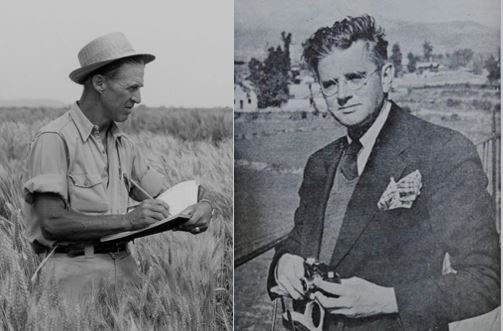Nutrition, health and food security
As staple foods, maize and wheat provide vital nutrients and health benefits, making up close to two-thirds of the world’s food energy intake, and contributing 55 to 70 percent of the total calories in the diets of people living in developing countries, according to the U.N. Food and Agriculture Organization. CIMMYT scientists tackle food insecurity through improved nutrient-rich, high-yielding varieties and sustainable agronomic practices, ensuring that those who most depend on agriculture have enough to make a living and feed their families. The U.N. projects that the global population will increase to more than 9 billion people by 2050, which means that the successes and failures of wheat and maize farmers will continue to have a crucial impact on food security. Findings by the Intergovernmental Panel on Climate Change, which show heat waves could occur more often and mean global surface temperatures could rise by up to 5 degrees Celsius throughout the century, indicate that increasing yield alone will be insufficient to meet future demand for food.
Achieving widespread food and nutritional security for the world’s poorest people is more complex than simply boosting production. Biofortification of maize and wheat helps increase the vitamins and minerals in these key crops. CIMMYT helps families grow and eat provitamin A enriched maize, zinc-enhanced maize and wheat varieties, and quality protein maize. CIMMYT also works on improving food health and safety, by reducing mycotoxin levels in the global food chain. Mycotoxins are produced by fungi that colonize in food crops, and cause health problems or even death in humans or animals. Worldwide, CIMMYT helps train food processors to reduce fungal contamination in maize, and promotes affordable technologies and training to detect mycotoxins and reduce exposure.
Are you a wizard or a prophet?
 Nutrition, health and food security
Nutrition, health and food security
New book highlights our relationship with nature and humanity’s future and tackles the age-old question: Can we control nature or are we, like all other species, bound by its laws?
Emergency seed fuels quick farm recovery in drought-affected Ethiopia
 Climate adaptation and mitigation
Climate adaptation and mitigation
In response to Ethiopia’s worst drought in 50 years and a critical shortage of seed in 2016, CIMMYT and partners delivered over 3,400 tons of high quality seed to farmers.
Innovation leads South Asia’s new Green Revolution
 Nutrition, health and food security
Nutrition, health and food security
Leaders from across South Asia recently called for increased investment in conservation agriculture to protect future food systems across the region.
New Publications: Mitigating climate change effects on food security
 Nutrition, health and food security
Nutrition, health and food security
A new study on climate change patterns indicates that climate change could reduce total crop production 23 percent by 2050
Australian High Commissioner to India visits project fields
 Nutrition, health and food security
Nutrition, health and food security
This November, the work of the SRFSI project was marked with notable recognition by the Australian Government with a visit from the Australian High Commissioner to India, Harinder Sidhu.
New systems analysis tools help boost the sustainable intensification of agriculture in Bangladesh
 Nutrition, health and food security
Nutrition, health and food security
In South Asia, the population is growing and land area for agricultural expansion is extremely limited. Increasing the productivity of already farmed land is the best way to attain food security.
World leaders: Back climate change action in agriculture to give our food system a fighting chance
 Climate adaptation and mitigation
Climate adaptation and mitigation
Governments must raise, not cut, funding for food security
 Nutrition, health and food security
Nutrition, health and food security
Source: Financial Times (7 Nov 2017)
Research into future-proof crops is needed to combat hunger, conflict and migration.
A network for future-proof foods to combat hunger, conflict and migration
 Nutrition, health and food security
Nutrition, health and food security
CIMMYT wheat physiologist Matthew Reynolds presents a new proposal for expanding the wheat network to include other major food crops and speed farmers’ adoption of vital technologies.
Borlaug Dialogue delegates widen net to curb threat from fall armyworm
 Nutrition, health and food security
Nutrition, health and food security
World Food Prize laureates have joined forces with an international alliance battling the fall armyworm, an aggressive pest indigenous to the Americas with a voracious appetite, and now widespread throughout Africa.
Wheat scientist receives Monsanto award for promising work on yield potential
 Nutrition, health and food security
Nutrition, health and food security
A scientist whose work is projected to significantly increase wheat production for smallholder farmers around the world has won the 2017 Ted Crosbie MBBISP Impact Award presented by Monsanto.
Borlaug Dialogue delegates to discuss strategy for tackling Fall Armyworm menace in Africa
 Nutrition, health and food security
Nutrition, health and food security
B.M. Prasanna at 2017 Borlaug Dialogue on expert panel to discuss the strategic approach for managing the pest menace in Africa.
Project helps African farmers identify regional best practices
 Climate adaptation and mitigation
Climate adaptation and mitigation
Traditional farming systems in Africa must be updated for today’s climate and market challenges, according to a new article from the University of Queensland.
Three technologies that are changing agriculture in Bangladesh
 Capacity development
Capacity development
In agrarian countries like Bangladesh, agriculture can serve as a powerful driving force to raise family incomes and the nation’s entire economy.
Project to boost Nepal’s seed sector meets to discuss a way forward
 Nutrition, health and food security
Nutrition, health and food security
Eleven seed companies shared progress and lessons learned in enhancing Nepal’s seed sector during a recent meeting held in Kathmandu, Nepal.

